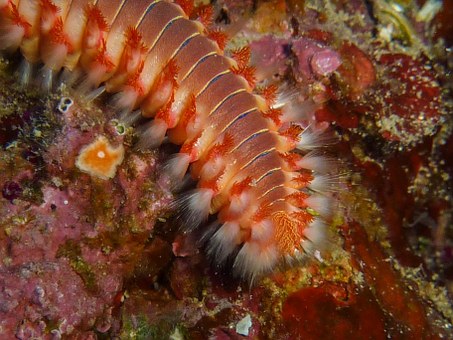
Keep aside Stranger Things' 'Demogorgon'. People are going all bonkers after watching an utterly terrifying creature in Blue Planet 2. Though the creature comes with an incredibly cute name, it is giving people a share of their worst nightmares.
Fans of the BBC documentary voiced by David Attenborough couldn't keep calm. Numerous took to Twitter to share the chill they experienced while watching the show. The giant carnivorous deep-sea worm is called a Bobbit.
Apparently, the ancestry of this creature stretches back more than 400 million years. However, one should not be deceived by the name. It might sound sweet but in no way can it be taken for granted. The name has a weird history of its own. Here are six terrifying facts about the deep sea monster.
Eunice aphroditois
The creepy worm comes by the scientific name Eunice aphroditois. It ranges from dark brown to golden red along with a stunning purple hue. It is covered by white or pale rings.
Bobbit worm myth
Bobbit worms are named after Lorena Bobbit who cut off her abusive husband's genital. It is generally believed that the female worm cuts off the male genital after mating and feeds it to her younger ones.
But, this is not true. Bobbit worms are 'polychaetes'. The males and females spew the sperms and eggs into the water, where the egg is then fertilized. A mucus cocoon is formed around the eggs. Female Bobbit worms, therefore, don't care for the larva and certainly doesn't feed them.
Claws and Jaws
What seems like the claws are in fact the jaws. There are two types of jaw pieces in a Bobbit worm. It has one pair of mandibles and four to six pairs of maxillae. The pointed hooked structures are the maxillae. They have one pair of eyes below the antennae.
How big can they get?
The ambush predators can grow up to 9 feet in length, making it one of the worst enemies for many fishes and crabs. They are found on the ocean floor at a depth between 33 feet and 130 feet. They can be typically found in the warmer ocean water, surrounding the Indo-Pacific region.
A deadly predator
Bobbit worms are predatory animals feeding on fish, crabs and other underwater species. They bury themselves in the ocean floor, only exposing their five antennae which can sense movement. Once they sense their prey, the worm attacks it with their razor sharp teeth and pulls it underground.
The deadly bristles
One should never touch a Bobbit worm as their body is composed of numerous bristles which are in fact nerve-damaging. The bristles can deliver a painful sting. If one of these bristles pierces through the skin, one might suffer from permanent nerve damage.
Bobbits are therefore nothing less than a shark and nothing short of a nightmare. Before stepping into the ocean, make sure to wear the slippers tight.









